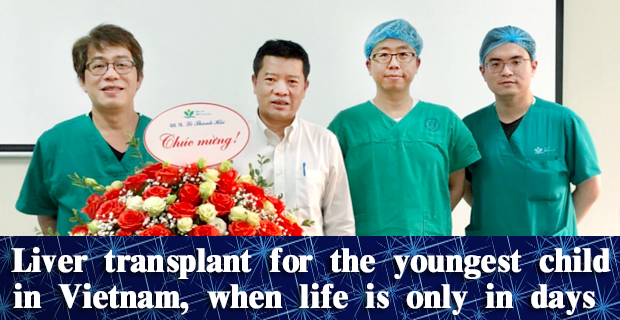
Suckhoedoisong.vn - Just ready to fight COVID-19, but in just 3 days, the doctors of the National Hospital of Pediatrics performed two liver transplants for two patients with congenital biliary atrophy, liver failure.
The last stage, including the youngest child in Vietnam, was nine months old and weighed 7.5 kg.
"Brain balance" decided to transplant the liver for children during the stressful outbreak of COVID-19
On the afternoon of March 18, the National Hospital of Pediatrics announced successful liver transplant surgery for two special cases, including the smallest case in Vietnam to have a liver transplant so far. It was a 9-month-old pediatric patient who weighed only 7.5 kg (Quang Ngai), a baby with severe cirrhosis. Another female pediatric patient is 20-month-old hypertension (Phu Tho).
Both patients suffered from biliary atrophy, the liver secretes bile but does not enter the bile ducts, which stagnates and destroys liver cells.
TS Senior doctor Nguyen Pham Anh Hoa, Head of Hepatology Department, National Hospital of Pediatrics, said that both patients had the onset of illness from the newborn period with prolonged, long-lasting jaundice symptoms that will lead to cirrhosis and liver failure. The small body suffers from a very severe condition right from the moment of birth, a severe decompensated cirrhosis and other complications such as recurrent biliary tract infection, esophageal varices,causing gastrointestinal bleeding, increased portal venous pressure, impaired hepatic function.
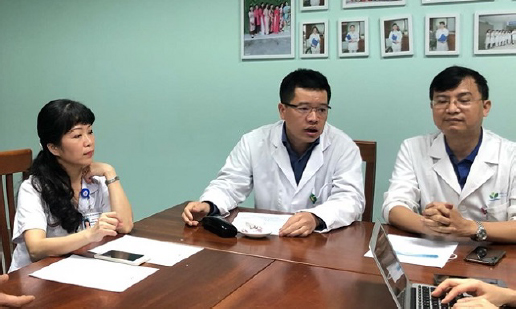
▲Dr. Pham Duy Hien - Deputy Director of the National Hospital of Pediatrics (in the middle) shared information with the press about 2 liver transplants
Right from birth, with this pathology, TGB was operated by Kasai (congenital biliary atrophy) at a hospital in Ho Chi Minh City connecting the umbilical cord to the jejunum. Meanwhile, the hypertension was also intervened by the National Hospital of Pediatrics with Kasai technique. However, the condition was too severe, liver function after surgery was increasingly impaired.
The lives of children and their families seem hopeless. The only way to keep them alive is to have a liver transplant.
However, according to Dr. Anh Hoa, this is a very difficult decision in the context that the hospital is working with the whole country to devote manpower to the fight against COVID-19, the patient is in a serious condition, one of the two patients is a very young child, 9 months old. And, with a pediatric liver transplant, doctors always face a lot of hassles.
"The life of a patient is in days. Without transplantation, there will be no other option for the child" - Dr. Pham Duy Hien, Deputy Director of the National Hospital of Pediatrics and Director of Internal Surgery Center Pediatric and Head of General Surgery said.
Therefore, in the middle of the epidemic season, the hospital was struggling against COVID-19, but the team received the support of the Hospital Director and decided to perform these two difficult transplants to save the patients. with the professional support of Professor Chin-su Liu's help and colleagues from Veterans General Hospital - Taiwan GS. Dr. Le Thanh Hai - Director of the National Hospital of Pediatrics said that liver transplantation is difficult surgery, liver transplantation for children is particularly difficult surgery due to complex anatomical structure, severe underlying disease, High level of surgery, resuscitation anesthesia and pre- and post-operative care.
“In liver transplantation for children, the National Hospital of Pediatrics is the place where successful liver transplants have been successfully performed in children, especially difficult ones such as liver transplantation in small children, low-weight children, liver transplants. from unrelated blood donors ... The National Hospital of Pediatrics is also the place with the largest number of children. That is the basis for doctors to believe that they will succeed two difficult cases, saving them from the threat of life "in days" - Prof. Dr. Le Thanh Hai shared.
Overcoming unprecedented challenges to win
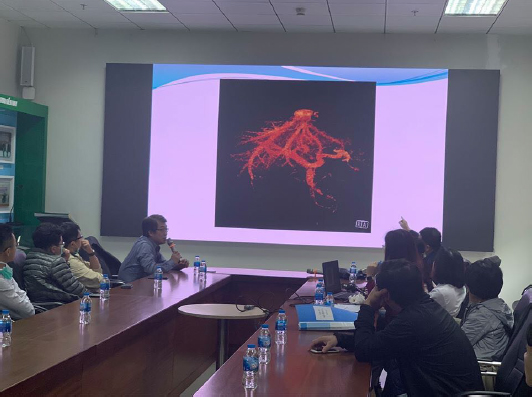
▲Experts carefully consulted before conducting two stressful and challenging liver transplants
After conducting the consultation, the doctors decided to conduct a liver transplant for two diseases. Both cases received liver from their biological parents, in which a 20-month-old infant received a liver from a mother, and a 9-month-old received the liver from his father.
According to Dr. Hien, liver transplantation is a very complicated technique,especially transplantation in the situation of a very small baby, severe gastrointestinal bleeding, severity of cirrhosis, portal vein (an important blood supply vein for the liver). ) is narrowed. During surgery, doctors have to perform a lot of procedures to increase blood flow to the portal vein, during surgery, the
risk of bleeding is very high. Meanwhile, on the donor side there is also an abnormal arterial system that supplies the liver transplant.
In the 20-month-old case, the most difficult case is the mother's liver anatomy that requires angioplasty techniques. "The average person has only one liver vein for the transplanted liver, but MTPD - the mother of the child has three liver veins. We have to shape these three veins into one to connect to the recipient'sliver vein. "- Dr. Pham Duy Hien said.
Then after the surgery, the child will be at risk of developing hepatic venous thrombosis, if the recovery is not good, blocking the entire system in the liver will be dangerous.
“We have to be extremely careful when we remove a piece of liver transplant but still have to be absolutely safe from damaging the rest of the liver. This is a surgical challenge that doctors have overcome and successfully operated ”- Dr. Pham Duy Hien
In young children, another difficulty is the very small hepatic artery aperture, only 2mm. Doctors must use surgical microscopes to connect the two ends of the arteries.
According to Dr. Nguyen Anh Duong, Head of the Department of External Resuscitation, after the surgery, the baby had liver venous thrombosis. If the resuscitation is not done well, it can block the entire blood vessel system in the liver, be dangerous for the graft or will increase bleeding. "Fortunately, the high technology in surgery has overcome the flow in the portal vein" - Dr. Duong said.
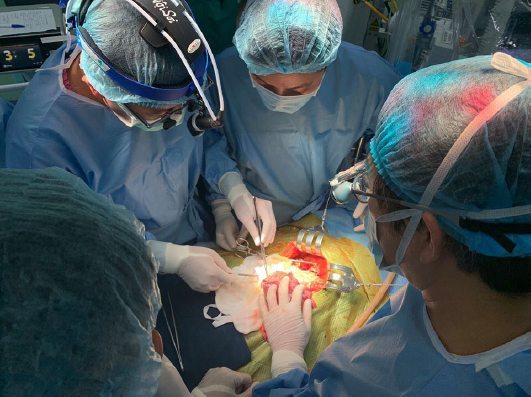
▲Doctors conduct liver transplants for children
With the youngest pediatric case, Dr Hoa said, the younger the liver transplant is, the greater the risk of catastrophic complications and post-transplant complications. The smaller the liver transplant is, the bile duct is weak and weak so it is easy to be crushed if not carefully stitched, the arteries are easy to separate and easily twisted. With pediatric liver transplantation, difficulties in both surgical and resuscitation problems.
The youngest child - TGB, 9 months old - was consulted many times by doctors to conduct a liver transplant with a donated liver. The difficulties that were expected by the doctors were no small challenges for the team. This child has a severe degree of cirrhosis, the portal vein (an important blood supply vein to the liver) is narrowed. During surgery, doctors have to perform a lot of procedures to increase blood flow to the portal vein. Meanwhile, his father also had abnormal artery system supplying liver transplant.
And life has revived ...
The first operation took 9 hours and the second one took about 10 hours. The postoperative condition is temporarily stable, the patient has received intensive care after surgery and is currently monitored, treated and cared for in the Hepatobiliary Department - Gastroenterology, Hepatology and Nutrition Center - Pediatric Hospital. Center.
For successful surgery for the baby, doctors must be extremely careful when removing a piece of liver transplant but still have to be absolutely safe, not to damage the rest of the liver. This is a surgical challenge that doctors have overcome and successfully operated.
Another difficulty is that in pediatric patients, the hepatic artery aperture is very small, only 2 mm. Therefore, during surgery, doctors must use surgical microscopes to connect the two arteries.
Three days of performing two transplants, the National Hospital of Pediatrics mobilized nearly 40 doctors and doctors to take part in the collection and transplantation of the liver from the living donor during the 9-hour transplant for hypertension and nearly 10 hours for the transplant. TGB baby Nearly 20 days after surgery, the two babies have been miraculously revived, being monitored at the Hepatobiliary Department - Gastroenterology, Hepatobiliary and Nutrition Center, National Hospital of Pediatrics.
Regarding combating rejection, TS. Dr Nguyen Pham Anh Hoa said that if adults have to use anti-rejection medication for a lifetime, with children, the ability to tolerate grafting is better than adults. Therefore, the amount of anti-rejection medication by weight will be reduced.
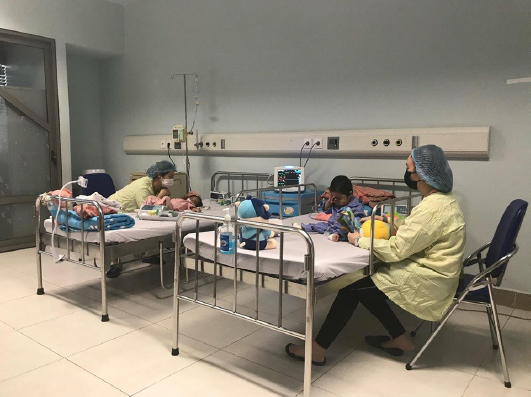
▲After the liver transplant, two children were healthy and about to be discharged from the hospital
The doctors of the National Hospital of Pediatrics affirmed that, at present, the National Hospital of Pediatrics is the place to carry out the most pediatric liver surgeries, including the youngest one in Vietnam. “Although we do not guarantee 100% of surgical techniques, only about 80%, we have performed the most special liver transplants. We have successfully implemented emergency liver transplants that are only prepared for 8-10 hours by 100% of hospital manpower. We have also performed other liver transplants with blood type, complex forming in small vessels ”- said Dr. Hoa on behalf of the kip.
In the next few days, the children are discharged from the hospital, returning to normal life. Dr. Pham Duy Hien added that, from the first transplant in 2005, the National Hospital of Pediatrics successfully performed liver transplants for 18 cases, most of which were children under 10kg.
Two successful liver transplants, including a 9-month-old child, once again marked the advancements in organ transplantation and the hospital's efforts to treat unfortunate children.